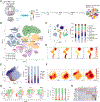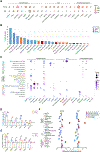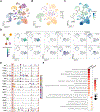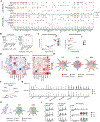Exercise reprograms the inflammatory landscape of multiple stem cell compartments during mammalian aging
- PMID: 37080206
- PMCID: PMC10216894
- DOI: 10.1016/j.stem.2023.03.016
Exercise reprograms the inflammatory landscape of multiple stem cell compartments during mammalian aging
Abstract
Exercise has the ability to rejuvenate stem cells and improve tissue regeneration in aging animals. However, the cellular and molecular changes elicited by exercise have not been systematically studied across a broad range of cell types in stem cell compartments. We subjected young and old mice to aerobic exercise and generated a single-cell transcriptomic atlas of muscle, neural, and hematopoietic stem cells with their niche cells and progeny, complemented by whole transcriptome analysis of single myofibers. We found that exercise ameliorated the upregulation of a number of inflammatory pathways associated with old age and restored aspects of intercellular communication mediated by immune cells within these stem cell compartments. Exercise has a profound impact on the composition and transcriptomic landscape of circulating and tissue-resident immune cells. Our study provides a comprehensive view of the coordinated responses of multiple aged stem cells and niche cells to exercise at the transcriptomic level.
Keywords: aging; exercise; hematopoietic stem cells; inflammation; muscle stem cells; myofibers; neural stem cells; scRNA-seq; skeletal muscle; subventricular zone.
Published by Elsevier Inc.
Conflict of interest statement
Declaration of interests J.C.W. is a co-founder of Greenstone Biosciences but has no competing interests as the work presented was performed independently.
Figures







References
Publication types
MeSH terms
Grants and funding
- S10 OD025212/OD/NIH HHS/United States
- R01 AG071783/AG/NIA NIH HHS/United States
- R01 HL126527/HL/NHLBI NIH HHS/United States
- R01 AG047820/AG/NIA NIH HHS/United States
- P01 AG036695/AG/NIA NIH HHS/United States
- R01 AR073248/AR/NIAMS NIH HHS/United States
- P30 CA125123/CA/NCI NIH HHS/United States
- R01 HL130020/HL/NHLBI NIH HHS/United States
- R37 AG023806/AG/NIA NIH HHS/United States
- P30 DK116074/DK/NIDDK NIH HHS/United States
- R01 AG068667/AG/NIA NIH HHS/United States
- I01 BX002324/BX/BLRD VA/United States
- R01 DK092883/DK/NIDDK NIH HHS/United States
LinkOut - more resources
Full Text Sources
Medical
Molecular Biology Databases

